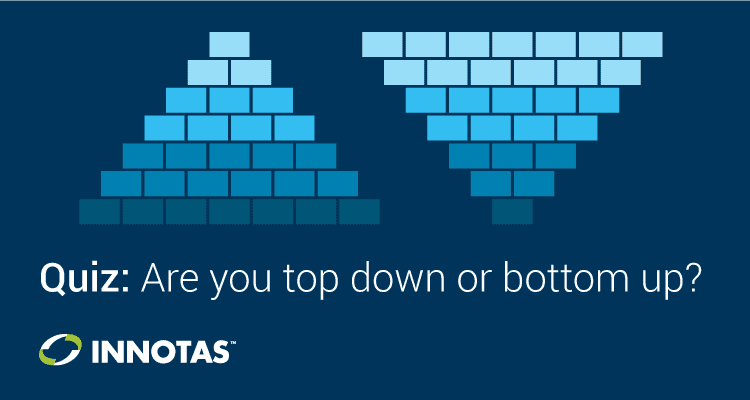
Why does it matter?
Both the top down and bottom up approaches are integral to project and portfolio success. However, it will significantly help you to know what your current approach is. With this awareness comes discussion on whether this is the approach you want. Many PMOs start out with a bottom up approach, but eventually grow and mature into the top down approach. Both methods are needed, but using a top down approach signifies PMO maturity and influence across the organization.
Use the questions below to determine what your tendencies are today. Think about how you and your PMO members would act today, not your desired end state.
- What matters most to you?
- Having a single place where the team can store their project details
- Having data available to facilitate strategic conversations
- Seeing reports that aggregate project data from multiple project managers
- It’s 5pm on Friday afternoon. Your boss walks in to your office asking for several reports for a Monday morning meeting. What do you do?
- Immediately start crying and beg for mercy
- Frantically call/email several project managers to ask them to send you their project updates immediately, then spend the next several hours compiling it all
- Run the requested reports on real-time data in a matter of minutes by using report templates. Send it to your boss and enjoy your weekend.
- You are looking for a PPM solution that your team will be happy using. The MOST important criteria is:
- Cool and interesting UI
- Ease of use, intuitive navigation
- Ability to quickly access dashboards with accurate data
- How are you assigning resources to work?
- Walk down the hallway and ask a resource if they have time to take on a new project
- Add resources to specific task with how many hours they should work on it
- Start by assigning roles, then resources, to the project as a whole. Then get down to tasks as needed
- When it comes to annual planning, what is your approach?
- Spend a few weeks gathering requested projects and put it in a spreadsheet to prioritize
- Meet with a committee a few times each year to talk about which projects to move forward with
- Monthly conversations with a selected committee to strategically align work to organizational goals and understand resource and budget availability
Done! This quiz most likely brought up some feelings of “The real answer is Choice 2, but I wish we were more efficient so I could answer Choice 3.” It’s natural to want this. Remember, everyone starts with the bottom up method, but it takes those with persistence and determination to improve processes and get to a top down approach.
If you chose mostly 1s: Whether you’re a new PMO or at a smaller company, it looks as though you’re working with a bottom up method. You are likely tracking projects and resources, perhaps even financial data. You may be getting in to task detail able to represent phases or milestones. Your challenges may be compiling the data, assigning resources, or getting executive support.
Next Steps: This is a great place to start out. Ultimately, you will find out that it’s challenging to collect everything and roll it up to your executives. As you continue on your path to gain maturity, keep in mind that you now have the foundation, but it’s alright to push your executive team to see the meaning and significance of the top down approach. While the PMO Manager may have enough information to oversee the PM workload, it’s unlikely that it’s easy or convenient to roll this up to an executive level.
If you chose mostly 2s: You have likely been managing your projects individually for some time and are in transition. Your PMO understands the value of the top down approach is wise. Regardless of whether it’s fast or slow progress, you’re on the track to being able to easily aggregate data across multiple projects and resources.
Next Steps: Stay the course! If you need help convincing the PMO and/or the rest of the organization that this is the right move, take a look at this short video to show the value of fully moving to a top down approach.
If you chose mostly 3’s: Congratulations, you have made it to the big leagues! You and your executive team clearly plan strategically. It’s clear what people are working on and how much time they are spending on that work. You recognize the need for both top down and bottom up, and that they can in fact live in harmony together. PMs have the details they need to manage team members’ work, while the leadership team can view this big picture and look for trends.
Next Steps: If you haven’t already, it’s time to start tracking time. This will take you over the finish line on your path to PMO maturity. It provides valuable insight into where you are actually spending time versus where you think you are spending time. Rolling this up to the portfolio and organization level, the leadership team will see how they are meeting the strategic drivers and goals. Don’t think your PMs will be onboard with this? Check out how time tracking can benefit PMs in this blog post.
After reviewing your answers and the next steps, share the results with your team. This is a positive way to benchmark your place on your journey to PPM maturity. Retake this quiz in 6 months to see if your answers have changed. The end goal is not only taking a top down approach, but achieving balance between the two. Get that harmony by connecting the what (project details) with the how (your big picture goals) to realize perfect harmony.




